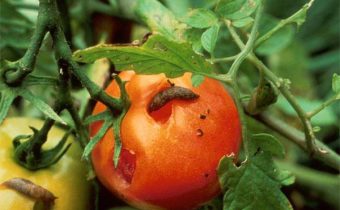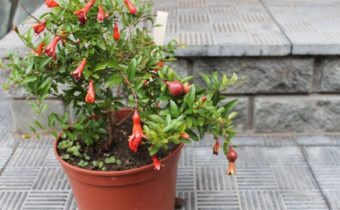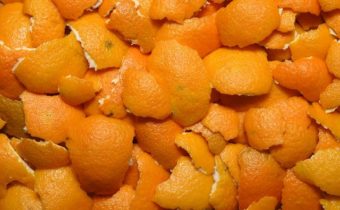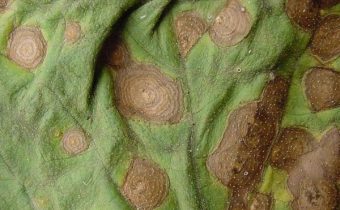5 ways to use coffee in a tomato garden
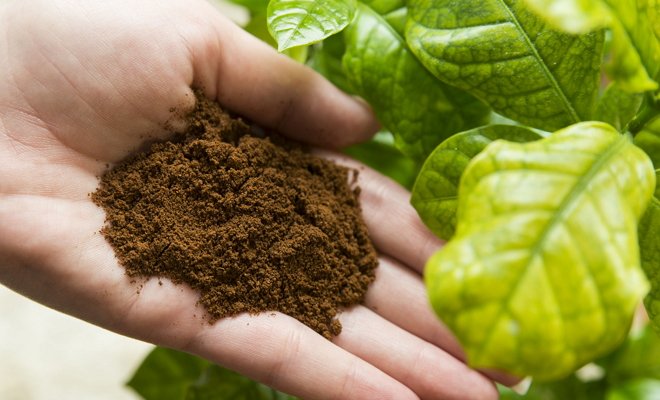
Coffee grounds even after brewing remain a source of trace elements that are part of complex chemical fertilizers. Small concentrations of these substances, a long period of decomposition of the coffee itself, all this allows you to successfully use the mass as a fertilizer for garden and garden crops.
How does coffee
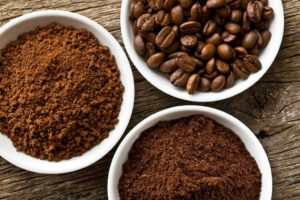
Sleeping coffee mass can be used both in the open field and in greenhouses and even in home gardening. For several decades, it was believed that the application is justified only for alkaline soils because of the natural acid grains. But research and measurements have shown that such compounds are completely washed out in the brewing process, even for a short time, therefore the fertilizer has a neutral PH and can be used in any areas.
Only ground coffee brewed without spices and sugar, preferably ground independently from whole grains, is suitable for use in a subsidiary farm.
Basic properties
For the soil and plants will be useful trace elements that are contained in the thick of:
- magnesium;
- potassium;
- phosphorus.
In various sorts of them up to 4 percent, an average of only 2. Therefore, coffee will act as a budgetary addition to complex feeding. Most garden pests do not tolerate the smell of milled grains, so avoid treated areas. The ground mass has the properties to harden with a permeable crust on the soil surface, effectively protecting it.
The thick decays very slowly, unlike tea. It will take about three years to completely absorb all the beneficial microelements into the soil. Therefore, processing is not carried out every year. Even the most fastidious plants in the care will not receive an excessive amount of additional trace elements, which will have a positive effect on the formation of greenery and fruits.
Effect on soil and plants
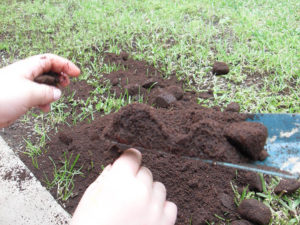
Especially widely used sleeping mass of coffee found as an improver soil due to its influence on the ground mass. The main advantage is the ability to have a certain effect depending on the initial characteristics. Simply put, coffee acts differently on soils with various disadvantages. Too light, airy, not compacted masses will thicken. This is especially true when planting root crops. Too heavy and dense will make loose, will improve breathability.
Coffee acts as the simplest drainage layer. Adding mass to the soil, which is characterized by stickiness and high specific gravity, will allow to avoid bogging, to increase the vertical conductivity. Although most of the pests avoid the essential oils contained in the grains, the earthworms, on the contrary, love the coffee grounds and tend to the treated areas.
It is not necessary to fertilize the entire plot, it is enough to treat the beds themselves to get the effect.
With active growth, all plants that require a maximum of nitrogen respond to coffee grounds fertilizers. Tomatoes, like bell peppers, eggplants, under the influence of this substance actively form fruitful ovaries. Therefore, feeding the sleeping mass is recommended for tomatoes.Slow return of nitrogen allows to avoid such phenomenon as overdose which beginner gardeners often face. Culture is afraid of such pests as slugs and snails, so the budget fertilizer would be an excellent option. To the soil was sufficiently saturated with potassium, it is recommended to make coffee with wood ash.
Ways to use
In order to use coffee in the spring, you need to start collecting it in advance, it will take quite a lot even for a small area. In the process of harvesting should be thoroughly dried mass. Otherwise, it will mold regardless of the method of use.
Coffee compost
Making homemade coffee compost is one of the most effective ways to use thick. Those cultures that can not be mulched can be fed regularly. The method is suitable also for house, houseplants, for landings in the greenhouse.
Only coffee grounds are not used because of their long decomposition period. For compost, it is better to mix coffee, straw, any leaves. If there are a lot of sleeping grains, it is acceptable to increase their mass to half, but compost from an equal amount of ingredients would be a good feeding.
The mass should ripen in a closed container and conditions of high humidity. All components are thoroughly mixed, put on the bottom of the container without sealing. Sprinkle bonemeal on top to speed up the process of rotting. Top cover with a layer of earth, enough 3-5 centimeters of soil. After pouring a little water and then moistened periodically. Air access should be provided by making several indentations in the mass with a stick up to 5 centimeters in diameter. Ripening period is about 4 weeks depending on the temperature. Such compost can be used for any crops in the garden.
Compost coffee is better to harvest in advance, it is well tolerated even frost, but in the spring you can immediately use it when planting.
Soil improver
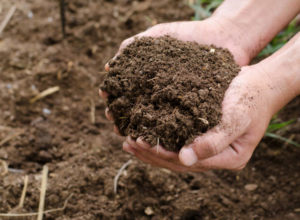
Use coffee as a soil improver should be if:
- alkali content increased;
- the soil is too light and unstable;
- the soil is too heavy;
- plot is not enough fed.
You can process the areas under all crops from radishes, carrots and tomatoes to roses and shrubs. It is possible to acidify the soil both completely and substantially. The result will depend not only on the amount of dried ground, but also on the feedstock. The stronger the roasting of the grains, the less the acidity of the finished fertilizer. Green grains are the most acidic, their indicator is about 4-5 units, but does not rise above this mark.
To improve the properties of the soil, you should lay up to 0.5 kg of ground coffee per one square meter of soil. Exceeding this dosage is not recommended. It is not enough to scatter the mass over the soil surface; it is better to dig the whole area thoroughly. It is convenient to do this already before planting.
Mulching
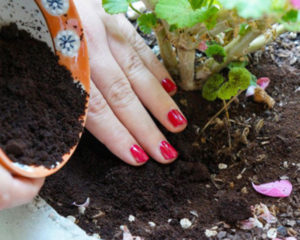
Mulch from the coffee grounds can solve several problems:
- protect the soil from drying out;
- eliminate cracking;
- get rid of weathering;
- attract earthworms;
- make the landings aesthetically appealing.
A well dried mass is used, as wet thick molds quickly. This is especially important when mulching house plants, planting in greenhouses.
Coffee grounds that are too thick can be crusted, which is not desirable. To avoid this, it is necessary to prepare a lighter mixture by adding as much small sawdust and dried grass. Such thick mulch not necessary. One of the advantages - such a mixture during irrigation will gradually give nutrients to the soil, so less complex fertilizers will be needed.
The "duration" of coffee grounds depends largely on the type of grinding, the larger it is, the longer the beneficial substances will be washed out.
The mulching of tomatoes with a coffee mass has found application in view of the fact that the thick scares off pests and contains a small amount of nitrogen. Tomatoes during the formation of the green part, the ovaries and flower stalks need a small amount of this trace element. Its excess can damage the crop, the lack of will cause the appearance of barren flowers. Therefore, mulching with a mass of coffee is most convenient, processing allows you to make nitrogen in small doses, but constantly.
Fertilizer
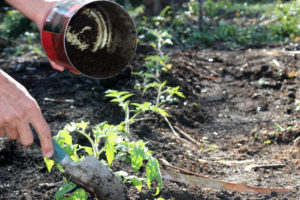
As a fertilizer, coffee can be used for almost all crops. It has a beneficial effect on the roots, greens, berries, even capricious ferns, roses and lilies bloom better when you make such a top dressing. Fertilizer can be applied in three ways:
- after planting dry;
- during landing in the hole;
- watering method.
With planting seedlings or coffee seed is laid directly in the wells. It can be mixed with any other active fertilizers intended for this vegetative period. One tablespoon per plant is enough.
After emergence of shoots it is possible to fertilize at any time. Low nutrient content can not damage the culture during the development of flowers, or during the period of pollination, or even at the moment of growth of the ovary. A noticeable result can be achieved by regularly feeding the plant from the moment of emergence or planting until the beginning of the ripening of the crop. After the formation of all the fruits to affect the productivity of the plant is already difficult, feeding coffee in this case is the least useful.
Dry fertilizer is one of the simplest and least laborious. It is necessary to scatter a small amount of coffee on the soil surface under the plants. Burst by gently mixing the thick with the ground. Liberally pour.
It is easy to make liquid fertilizer: pour warm water at the rate of 1 tablespoon per 300-400 grams of liquid. Let stand for about two hours. Without decanting, water the plants with the resulting liquid. After the soil dries, re-water it.
Wet fertilizer is not used at home, it can increase the risk of mold and mildew in pots. For ventilated open ground, an infusion of thicker is much better suited.
Pest Barrier
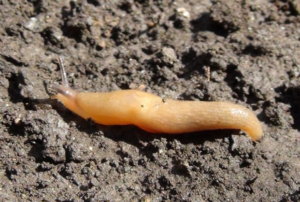
Protect planting from slugs and snails using coffee grounds can be simply by scattering it on the ground. This should be done both directly on the beds, and next to them. Pests will not be able to cross the area treated in this way, because they are afraid of even the smell of the seeds. Therefore, for protection it is better to choose the thick of the drink from a high degree of roasting. A sharper smell will scare away uninvited guests. The same applies to cats who love to dig in the ground or arrange toilets in the beds.
Protects coffee grounds and from such pests as:
- carrot fly;
- aphid;
- Drosophila;
- ants.
Flies and ants are particularly harmful to the roots, so to protect against them should be laid thick in the ground during the digging or plowing. You can make fertilizer at the time of planting. Aphid most often appears on shrubs and fruit trees, so it is advisable to use both dry and liquid fertilizer for deep tillage under plantings for protection.
Common mistakes
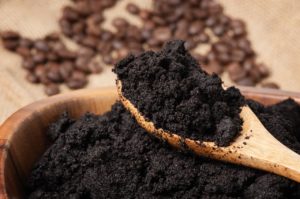
One of the most common mistakes gardeners and gardeners - the rejection of complex fertilizer when using coffee. The thick will not be able to replace all types of fertilizing and drugs from pests and diseases. This is a great option for processing already well-fertilized soil, maintaining its nutritional properties.
It is not allowed to use milk drink thick. Sugar can be washed under running water, but dairy enzymes will remain on the milled grains.In the future, this will lead to the appearance of fungal diseases in the soil and on plants.
The sweetener on plants will have the same effect as a regular sweetener. Therefore, it is necessary to take into account its presence in the drink.
Excess meal can ruin the plants, so you should stick to the average dosage. Caffeine does not stimulate active growth, contrary to popular belief, but inhibits vegetative functions.
Using coffee as a fertilizer is a great alternative to expensive all-season fertilizing. Cake versatility allows you to use it at any time from soil treatment in spring or late autumn to the active vegetative period in June-July.


